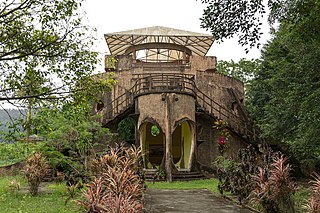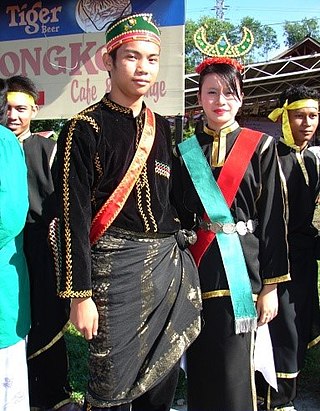Related Research Articles

Dusun is the collective name of an indigenous ethnic group to the Malaysian state of Sabah of North Borneo. Collectively, they form the largest ethnic group in Sabah. The Dusun people have been internationally recognised as indigenous to Borneo since 2004 as per the United Nations Educational, Scientific and Cultural Organization (UNESCO).

The Kadazans are an ethnic group indigenous to the state of Sabah in Malaysia. They are found mainly in Penampang on the west coast of Sabah, the surrounding locales, and various locations in the interior.

The Momogun Rungus are an ethnic group of Borneo, residing primarily in northern Sabah in the area surrounding Kudat Peninsular, Kota Marudu, Pitas Bengkoka Peninsular and Beluran. A sub-group of the Dayak, they have a distinctive language, dress, architecture, customs, and oral literature.

The Lotud people are an indigenous ethnic group residing in Sabah, eastern Malaysia on the island of Borneo. They reside mainly in the Tuaran district and also a portion of this tribe's population also reside in the village of Kampung Sukoli located in the Telipok suburban township of Kota Kinabalu city, all located in the West Coast Division of Sabah. Their population was estimated at 5,000 in the year 1985 but now believed to be more than 20,000. They are a sub-ethnic group of the Dusunic group, now also known as Kadazan-Dusun.
The Maragang or Kimaragang people are an indigenous ethnic group residing in Sabah, eastern Malaysia on the island of Borneo. They reside in the Kota Marudu and Pitas districts of Kudat Division. Their population was estimated at 10,000 in the year 1987. They are considered a sub-group of the Kadazan-Dusun, as their language belongs to the Dusunic branch of the Austronesian language family. They are primarily farmers, raising paddy rice, cocoa, and cash crops.
The Minokok are an indigenous ethnic group residing in Sabah, Malaysia. They reside near the headwaters of Kinabatangan River, in Sandakan Division. Their population was estimated at 2,000 in the year 1991. They are considered a sub-group of the Kadazan-Dusun, as their language belongs to the Dusunic branch of the Austronesian language family. About 35% of the population has been converted to evangelical Christianity, the remainder are animist.
The Rumanau are an indigenous ethnic group residing in Sabah, eastern Malaysia on the island of Borneo. They are known as the Lobu in the Keningau District near Lanas, and the Rumanau in the Masaum, Mangkawagu, Minusu areas of the Kinabatangan District along the Kinabatangan River, in Sandakan Division. Their population was estimated at 2,800 in the year 1991. They are a sub-group of the Kadazan-Dusun, although their language belongs to the Paitanic branch of the Austronesian language family.
The Mangka'ak are an indigenous ethnic group residing in Sabah, eastern Malaysia on the island of Borneo. They primarily reside in the Sandakan, Labuk-Sugut, and Kinabatangan districts in northeastern Sabah. The population of Mangka'ak was estimated at 20,583 in the year 2000. They are a sub-group of the Kadazan-Dusun, and their language belongs to the Dusunic branch of the Austronesian language family. The language is threatened with extinction, as most of the current generation use standard Malay in everyday speech.

Kadazan-Dusun are two indigenous peoples of Sabah, Malaysia: the ethnic groups Kadazan and Dusun. The Kadazandusun is the largest native group of Bumiputra in Sabah. They are also known as Mamasok Sabah, meaning "originals" or "indigenous people" of Sabah. The traditional worldview of the Kadazan-Dusun mentioned that they are descendants of Nunuk Ragang people. Kadazan-Dusun is recognised as an indigenous nation of Borneo with documented heritage by the United Nations Educational, Scientific and Cultural Organization (UNESCO) since 2004. Kadazan-Dusun is a bumiputera group in Malaysia and Sabah that has its own special rights from land rights, rivers, to maintaining customs.
The Ida'an language is a Malayo-Polynesian language spoken by the Ida'an people on the east coast of Sabah, Malaysia.

Nunuk Ragang is a site traditionally considered as the location of the original home of the ancestors of the Kadazan-Dusun natives who inhabit most of northern Borneo. The site, nearby a village named Tampias, is located at the intersection of the left and right branches of the Liwagu River to the east of Ranau and Tambunan in Sabah. The two river branches joined up to flow into the Labuk river and drain out into the Sulu Sea. At the site, and under a giant banyan tree, a settlement referred to as Nunuk Ragang was founded. The giant banyan tree was said to be able to give shade to a longhouse sheltering 10 families in it. The legend about Nunuk Ragang had been passed down via oral traditions to the younger generations. No archaeological dig has been carried out to establish the veracity of the legend.

Bisaya is an indigenous people from the northwest coast of East Malaysia on the island of Borneo. Their population is concentrated around Beaufort, Kuala Penyu, Menumbok, Sipitang, Labuan Federal Territory, and in Limbang District, Sarawak. The Bisaya tribe has many similarities with the Dusun Tatana tribe, especially in terms of language. It is evident that some of their dialogical language conversations are almost identical if they have a dialogue with each other. Nowadays the Bisaya living in Sabah are Muslims, while the Bisaya living in Sarawak are mostly Christians. In Brunei, they are referred as Dusun, Jati Dusun and Bisaya. The Bisaya is closely related, linguistically, with the Tatana Dusun of Kuala Penyu, Sabah.
Coastal Kadazan, also known as Kadazan Tangaa', is a dialect of the Central Dusun as well as a minority language primarily spoken in Sabah, Malaysia. It is the primary dialect spoken by the Kadazan people in the west coast of Sabah especially in the districts of Penampang, Papar and Membakut.
Central Dusun, also known as Bunduliwan, is one of the more widespread languages spoken by the Dusun peoples of Sabah, Malaysia.
The Greater North Borneo languages are a proposed subgroup of the Austronesian language family. The subgroup covers languages that are spoken throughout much of Borneo, as well as parts of Sumatra and Java, and Mainland Southeast Asia. The Greater North Borneo hypothesis was first proposed by Robert Blust (2010) and further elaborated by Alexander Smith. The evidence presented for this proposal are solely lexical.
The Paitanic languages are a group of languages spoken in Sabah (Borneo) Several go by the name Lobu.
The Sabahan languages are a group of Austronesian languages centered on the Bornean province of Sabah.
Tatana (Tatanaq) is a Sabahan language spoken in Sabah, Malaysia. Due to limited studies, it is hard to ascertain whether Tatana requires a category on its own or is considered a Bisaya variety based on its 90% linguistic intelligibility with the closely related Bisaya ethnic in Sabah. The current speakers of Tatana identify themselves as an ethnic subgroup of the Dusun people of Borneo. Jason Lobel (2013:360) classifies Tatana as Murutic rather than Dusunic.

Sabah is the third most populous state in Malaysia, with a population of 3,418,785 according to the 2020 Malaysian census. It also has the highest non-citizen population, at 810,443. Although Malaysia is one of the least densely populated countries in Asia, Sabah is particularly sparsely populated. Most of the population is concentrated along coastal areas, with towns and urban centers seeing the most population growth.

The Kudat District is an administrative district in the Malaysian state of Sabah, part of the Kudat Division which includes the districts of Kota Marudu, Kudat and Pitas. The capital of the district is in Kudat Town.
References
- ↑ Bonggi language has been removed per Adelaar & Himmelmann, The Austronesian languages of Asia and Madagascar. Routledge, 2005, and Gana' per Glottolog.
- King, Julie K., and John Wayne King. 1984. Languages of Sabah: A survey report . C-78. Canberra: Pacific Linguistics, The Australian National University.
- Lobel, Jason William. 2016. North Borneo Sourcebook: Vocabularies and Functors. University of Hawaii Press. ISBN 9780824857790